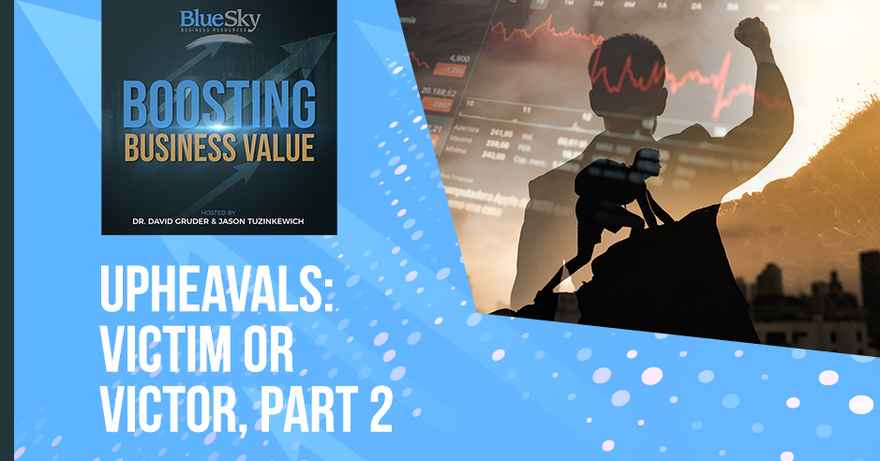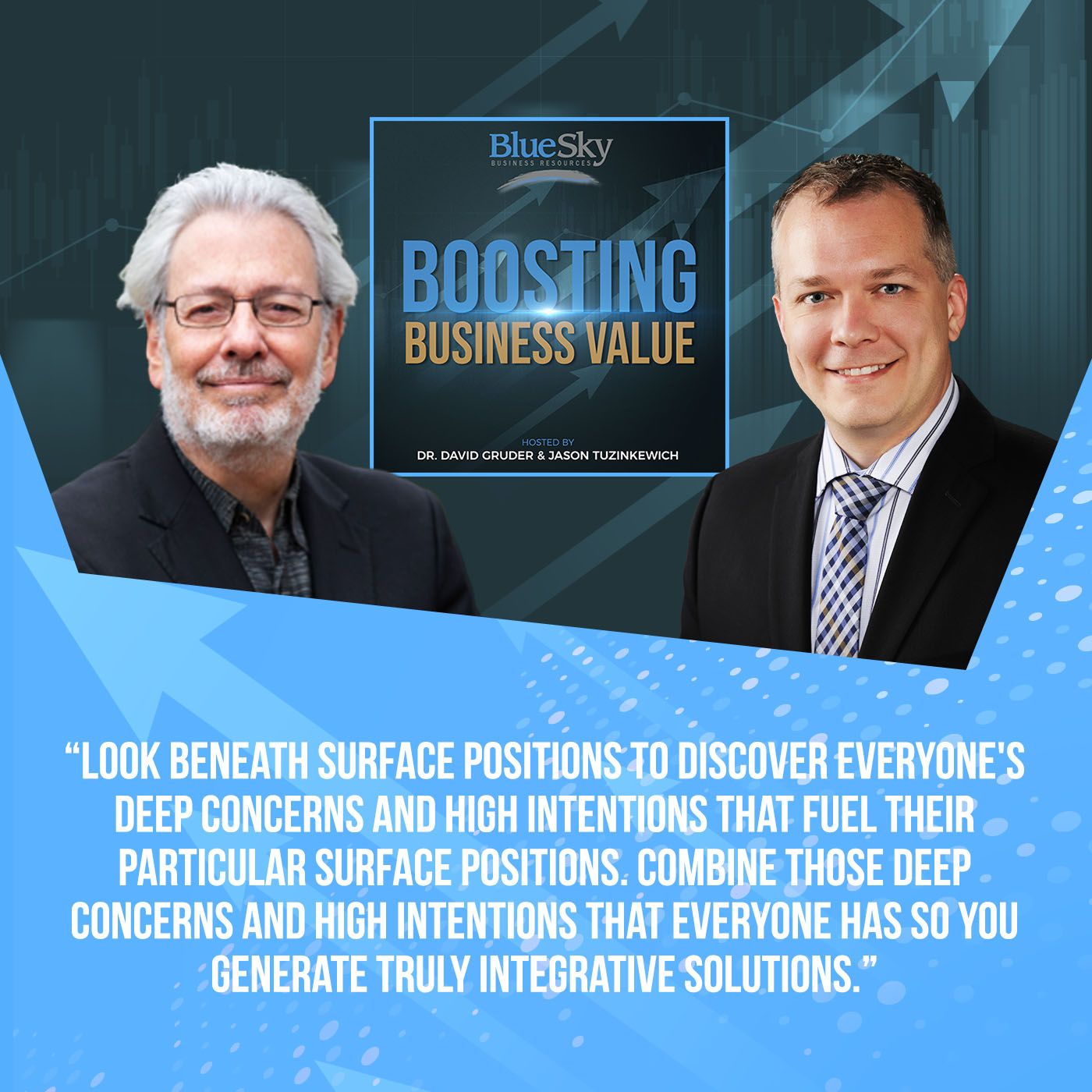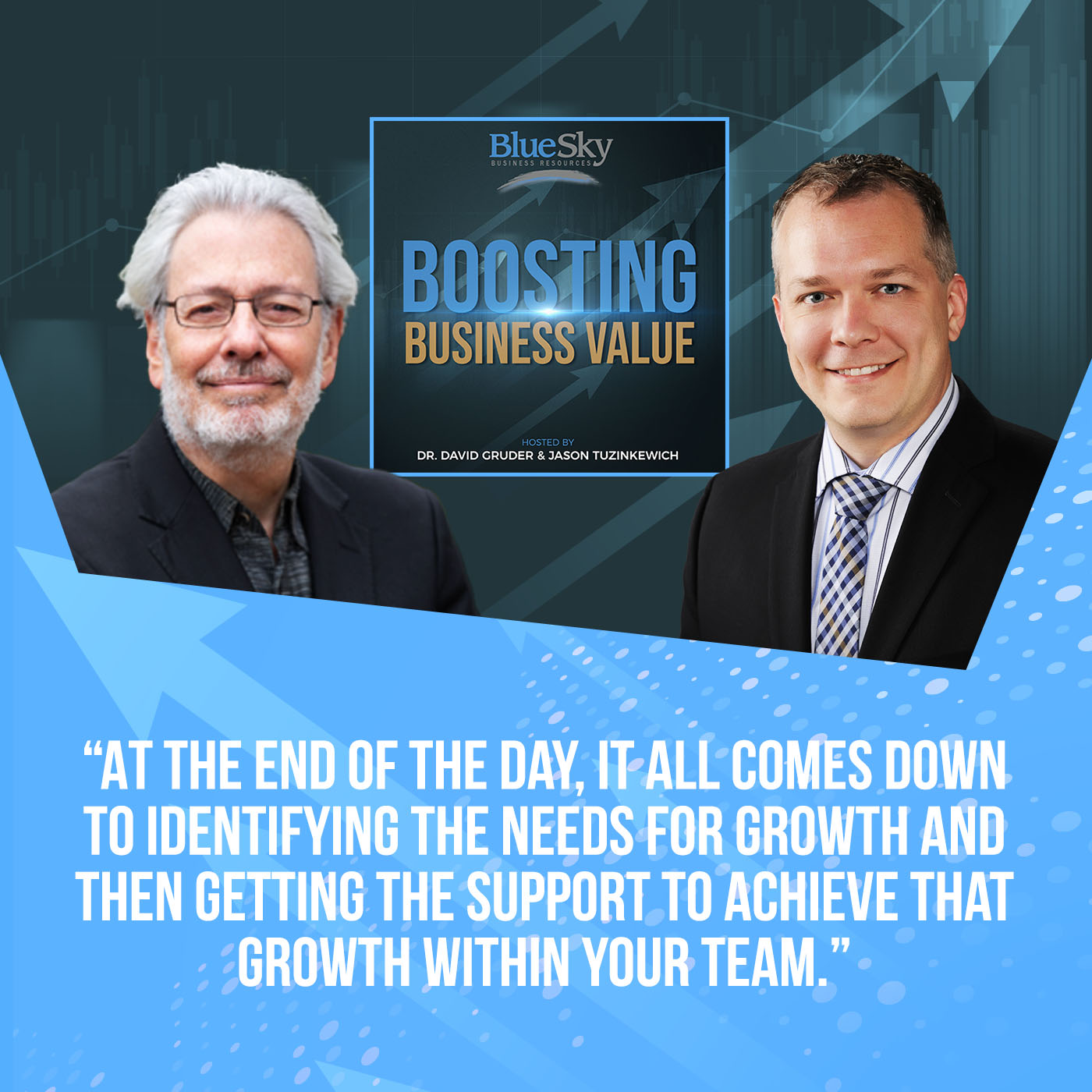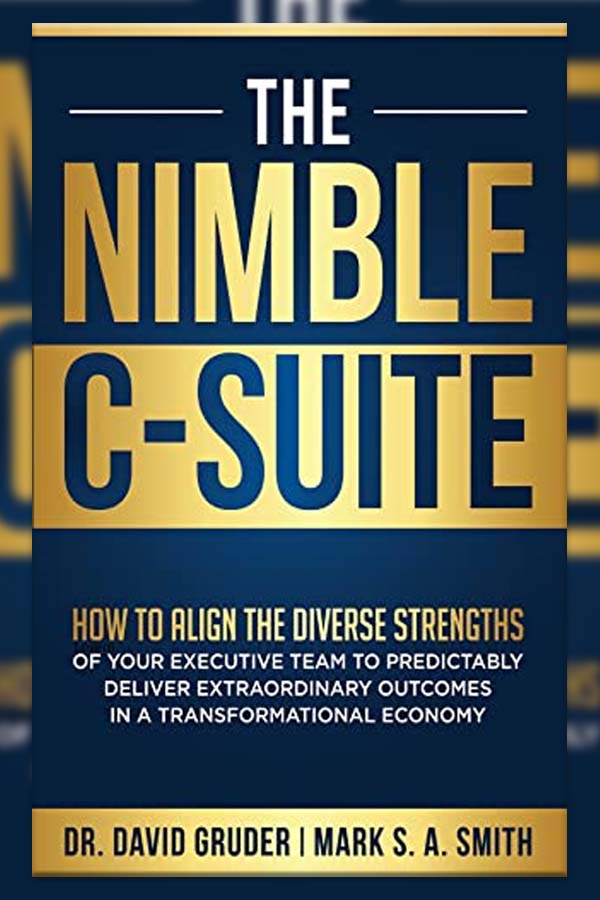Ep. 07 - Upheavals: Victim Or Victor, Part 2

This is part two of a two-part series on becoming upheavals resilient. In the first part, we unpacked key types of upheavals that are important to be aware of, so you can minimize what's preventable and be more prepared to navigate what's unforeseeable. In part 2, Dr. David Gruder and Jason Tuzinkewich discuss ways you can make your company more upheavals resilient, so you can use upheavals as opportunities instead of being dragged under by them.
---
Watch the episode here
Listen to the podcast here
Upheavals: Victim Or Victor, Part 2
Becoming Upheavals Resilient
This is the second part of our two-part series on Becoming Upheavals Resilient. In the first part, we unpacked key types of upheavals that are important to prevent and monitor. Now we are going to get into the fun stuff. We are going to discuss ways to make your company more resilient against upheavals.
Let's start with the things that we think are important in becoming upheavals resilient. The first of those is understanding leader temperament or lenses. What too commonly happens among executive teams is that there's competition among the executives over whose perspective is going to dominate decision-making. That isn't what creates effective executive teams.
Here's the scoop. If you've got an operations officer, let's say, the chief operations officer has to have a very specific relationship with risk timeframe for decision-making, strategic planning, and tactical implementation. If we contrast that with the chief financial officer, they have got to have a very different set of risk tolerances.
You contrast that with the chief sales, marketing, or R&D person, and again, you get a whole different set of risk tolerances. Those are necessary differences. You don't want, for example, someone who is in the role of the chief financial officer to be all about change, innovation, and all of that stuff. The chief financial officer is supposed to be preserving predictability, organization, standards, and stability in an organization. That's what advocacy needs to be about.
Whereas in contrast, whoever is in charge of things like sales, marketing, research, and development, if they are not into transformation, change, innovation, and all kinds of stuff, which is the opposite of stability and predictability, then they are not going to be good in their role. It's crucial that leader teams develop a deep appreciation of what the temperament needs to be for each of the executives in their particular role and the lenses that each of those executives needs to look through in order to fulfill their role and voice on behalf of their responsibilities effectively.
That collaboration occurs on the team where there isn't this competition over whose lens is right. Instead, it is the creation of the co-creation of jigsaw puzzle, where all the necessary lenses on the part of each of the executives get to be pooled together to come up with integrative decisions about goals, timeframes, strategy, tactical plans, and all of those kinds of things. That's the first area that's crucial for upheavals resilience. It is all of the leaders having an authentic appreciation of every other leader and their own temperament and lenses so they can collaborate well together rather than try to dominate each other.
One of the neat things about going through this work of understanding the leader temperament and the lens is that once you understand these different temperaments and the needs within specific leadership roles, it becomes easier to determine as a team. Organically, who should carry the most weight in every different decision-making scenario? Historically, the CEO gets the final say.
In a thriving, organic, agile, and nimble culture, the CEO should be able to leverage the voice of everybody else to affect the best final say. That comes with an understanding of what you talked about, the temperament and the lenses, and knowing who should be given the most weight in every discussion. The more that there's transparency on that, the easier that collaboration becomes.
That's a beautiful add-on to what I was saying. Thank you for that. The second dimension of becoming upheavals resilient is something that I have long referred to as tensions competence. What that means is that things are very rarely black and white either/or, this or that, binary. They are very rarely that cut and dry, and yet people seek the clarity they think they get by oversimplifying things into either/or. That generally leads to poor decision-making and spawns upheavals.
Things are rarely black and white, either/or, this or that. They're rarely that cut and dry, yet people seek the clarity they think they get by oversimplifying things into either/or. And that generally leads to poor decision-making and spawns upheavals tensions.
Tensions competence on the other hand is the process or the emotional intelligence that allows us to be comfortable with ambiguity. Not to tolerate it permanently, but not to go into anxiety when an ambiguous or unclear situation appears. To approach that ambiguity with curiosity so that there's an emerging awareness of multiple dimensions and factors that are involved rather than the rigidity of either or thinking where we enter into both and thinking.
Synergized and integrative thinking is the essence of tensions competence. Mostly, people come into companies not having been trained in tensions competence skills. As leaders of a company, a leader, executive, or CEO can either complain about how none of their people have tensions competence or they can accept that we don't live in an educational system that develops tensions competence so that each company takes responsibility for developing that in their properly selected personnel.
This is one of those areas where the difference between the documents hanging on our walls becomes so apparent. When I talk to business owners, I say, “When it comes to making decisions, you've got to figure out what the knowledge needs are and what the knowledge to haves are. Somewhere after the needs are met, a decision must be made.” You've got this beautiful little tensions competence language and framework that I love, but that's because you've got different documents hanging on your wall. Kudos to you.
We are demonstrating it right now and throughout all of our episodes about looking at business through different lenses where you and I have had many discussions about how our lenses are complementary to each other. We synergize well with our lenses. We don't go into competition over my lenses better than your lens, or your lens is better than my lens. What's the bigger picture that emerges when we combine our lenses? That's part of tensions competence.
Although your lenses are awful nice.
Yours aren't too shabby yourself. Let's get past all this self-congratulation and move on to the third aspect of upheavals literacy. That is about impact literacy. We mentioned in part one of this two-part series, something called learned helplessness, which again, is where people have been trained into believing that they have less power, influence, or impact than they do, whether positive or negative.
The antidote to learned helplessness, which so many people come into companies with that mindset as a preexisting condition that needs to be retrained is impact literacy where we help people learn how to anticipate the impacts of their actions and commitments of following or not following through on those commitments that they make.
Inevitably, there are times when we can't fully anticipate what our impacts are going to be. As soon as we become aware of unintended impacts, we immediately bring those up so that we can make mid-course corrections in light of the unanticipated. Impact literacy is a skillset like tensions competence, and it's a skillset that's learnable and it's a skillset that is crucial to having an upheavals resilient company.
I keep thinking about this impact and helplessness portion and how big of a deal this is, and it's shocking to me that more people aren't talking about it. It's funny to me that almost everybody to a person is extraordinarily literate on received impact, but phenomenally illiterate on delivered impact. I think that's something that is important.
I love that you keep bringing this up. I appreciate it. The last element that we wanted to talk about is the ability or inability to plan strategically. This is another one of those things that's shocking to me, but real strategic planning, durable, robust strategy, and planning is not something you see very often, which boggles the consciousness because is so important in everything that we do.
Because of the fact that you don't see it very much in the educational system and you don't see it emphasized very much culturally in businesses, you end up with a lot of owners who are operators. This is where a lot of employees start to get the idea of, “These knuckleheads at the top don't know what they are doing. I could do this so much better. I'm going to start my own company and blow them out of the water because they are extraordinary tacticians.”
Great operators and great tacticians have a hard time understanding the difference between their excellence at the granular implementation and the macroscopic large-scale plan that leads to more effective durable implementation. The thing about a strategy is that it's not about saying, “Here's where we are. Here's where we are going.” It's about taking stock of what has to happen between here and here to get us there.
That's the part of strategic planning that is very much a learned skill. It's highly nuanced. If you and your team are lacking in this, this is one of those places where either establishing an executive mentor or getting support from a third-party team that can guide you through this process. It is going to be critical because if you don't have a long-term durable plan, then your life changes the second something unexpected happens. Whereas if you have a good strategy, that's something unexpected is built in, and so you know which direction to weave in and what adjustments to make. It's like, “That happened. Here's how we proceed.” That's the big difference and that's where people can become resilient to upheaval.
What I will add to that is it's important for business owners, executive teams, and boards to think about business success as essentially a three-legged stool. The first leg is vision, mission, goals, and strategy. The 2nd leg is tactical architecture and the 3rd leg is tactical implementation. This is part of why I'm a real advocate of the reorganization of executive teams of C-Suites into a T-Suite and an S-Suite.
The S-Suite is the strategy suite. It's the executives who are the strategic thinkers. The T-Suite is the executives who are the tactical thinkers. It's not that one is better than the other. They are both absolutely necessary. However, that strategy proceeds tactics, and businesses that do tactical implementation without a strategy end up floundering. They are doing the spaghetti-against-the-wall approach and that is not economically viable over the long run.
The S-suite executives are the strategic thinkers, and the T-suite executives are the tactical thinkers. They're both necessary. However, strategy proceeds tactics, and businesses that do tactical implementation without a strategy end up floundering.
More sophisticated than myself might even puff on an immersion pipe and say, “Sounds like you've got a leader temperament and lens issue here in these two different teams. Very interesting.”
Who might that be? I have to pull out my pipe now.
Yes, you will. I love that and I appreciate it. I like the idea that you brought up of having two divisions within the executive team to lead the tactical work and the visionary work. This ties into something that we talked about in episode one, which was making sure that you have one or more people who can lift their heads above the fray. Get out of what we are now calling the tactical work, the heads-down operational work, and keep an eye on the bigger picture as well as the external world around the organization. Now you are saying it's not one person, but it's this whole division within leadership and I love it. That's powerful.
For clarity, you didn't mean episode one of this show series, you meant part 1 of this 2-part series here.
It’s so true. Me and semantics. Watch out. We had a great conversation. We talked about a lot of issues and unknown challenges. Let's get back to my favorite part, which is how do we turn this all into success? How do people take everything that we have talked about and apply it to their business?
This is going to be pretty much a summary because we have already embedded this into what we have covered. What to look for in a solution? The first thing is to look for training in how to recognize leader temperament and lens differences. These necessary differences so that your executive team develops an authentic appreciation of why those temperament and lens differences are necessary and how to capitalize on them. That's the first thing to look for in a solution to becoming an upheavals resilient company.
The second, as we have talked about, is tensions competence training. Part of that I didn't mention earlier is training in how to look beneath surface positions. Surface positions end up in wars, in arm wrestling matches over whose position is right. The solution to that in tensions competence training is looking beneath surface positions to discover everyone's deep concerns and high intentions that fuel their particular surface positions. Combining those deep concerns and high intentions that everyone has so you generate truly integrative solutions.

Deal with the causes, not the symptoms.
Well said. The third of the four ingredients in becoming more upheavals literate or upheavals effective in a company is impact literacy, as we talked about before. Making sure that your team has impact literacy training that includes collaborative accountability mechanisms. It’s because the notion of accountability, as you so beautifully said previously, where accountability has been hijacked into a dirty word.
Accountability is not a coercion, punishment, or shame tactic, even though it's too commonly used or misused that way. Accountability is something that promotes and facilitates collaboration and healthy cultures. There are a small set of mechanisms of procedures that create collaborative culture building accountability that when those are installed, you get a highly impact literate culture.
Last but not least is strategic planning. Get the resources whether that's training, third-party support, or direct mentorship of the executive team. Get the support that you need to ensure that you can develop robust and durable strategic plans that build all the way down into implementable tactics. I love the fact that you had the tactical implementation and the tactical framework as two separate things.
The first few times you start writing a strategic plan. That tactical framework will be as shambles by the time you are done because you are going to learn. You are going to learn the nuances of how your operation works that you didn't pay attention to before when you were doing instead of working a plan. Getting the help to not only create these plans, but to create the strategic plan, create the implementation framework, implement, and then reiterate. Make the changes all the way back up that process that is necessary until you have a smooth and consistent flow of strategies that are working.
At the end of the day, it all comes down to identifying the needs for growth and then getting the support to achieve that growth within your team. Since we made our strategic success roadmap, also the key takeaways, I'm going to end this one a little different. I'm going to end it with a couple of challenges.

I'd like to challenge you, the reader, to come back to your team and talk about these opportunities for development in order to become upheavals resilient and ask your team, “How are we going to address these things? How will we receive and implement training to grow our team in a way that will make us more resilient? Who are our resources going to be? Who is the external team that will help us grow as an organization? What are the gaps in that external team and how do we go about filling those seats?” This will be very helpful. Blue Sky Business Resources is always available for a free consultation to help guide you in the questions that you have no answer to, but you've got your trusted advisors as well. I bet a lot of them can provide great resources also.
At the risk of sounding self-serving, I'm going to add one other takeaway, which is The Nimble C-Suite and The Nimble Company that companion volumes. It’s books that are available in print, digital, and audiobook versions. They are co-authored by Mark S.A. Smith and myself. They go into a lot of detail with many of the things that we have covered in this two-part series on becoming upheavals literate.
Great reads. I will second the recommendation to check those out.
Thank you for that. On behalf of Jason Tuzinkewich and myself, we want to thank you once again for reading this episode and hopefully both parts of this two-part series. As Jason and I have been saying all along, we do look forward to reading your thoughts, questions, topic suggestions, and other requests you might have because you are co-creating this show with us to the extent that you provide us with input about what's important to you.
Provide those to us in the comments section that accompanies every episode in our series. Along with that, we want to always invite you to click on the subscribe button so that you are notified as soon as a future episode drops and becomes available. Thank you once again for being with us and we look forward to joining you next time.


0 comments
Leave a comment
Please log in or register to post a comment